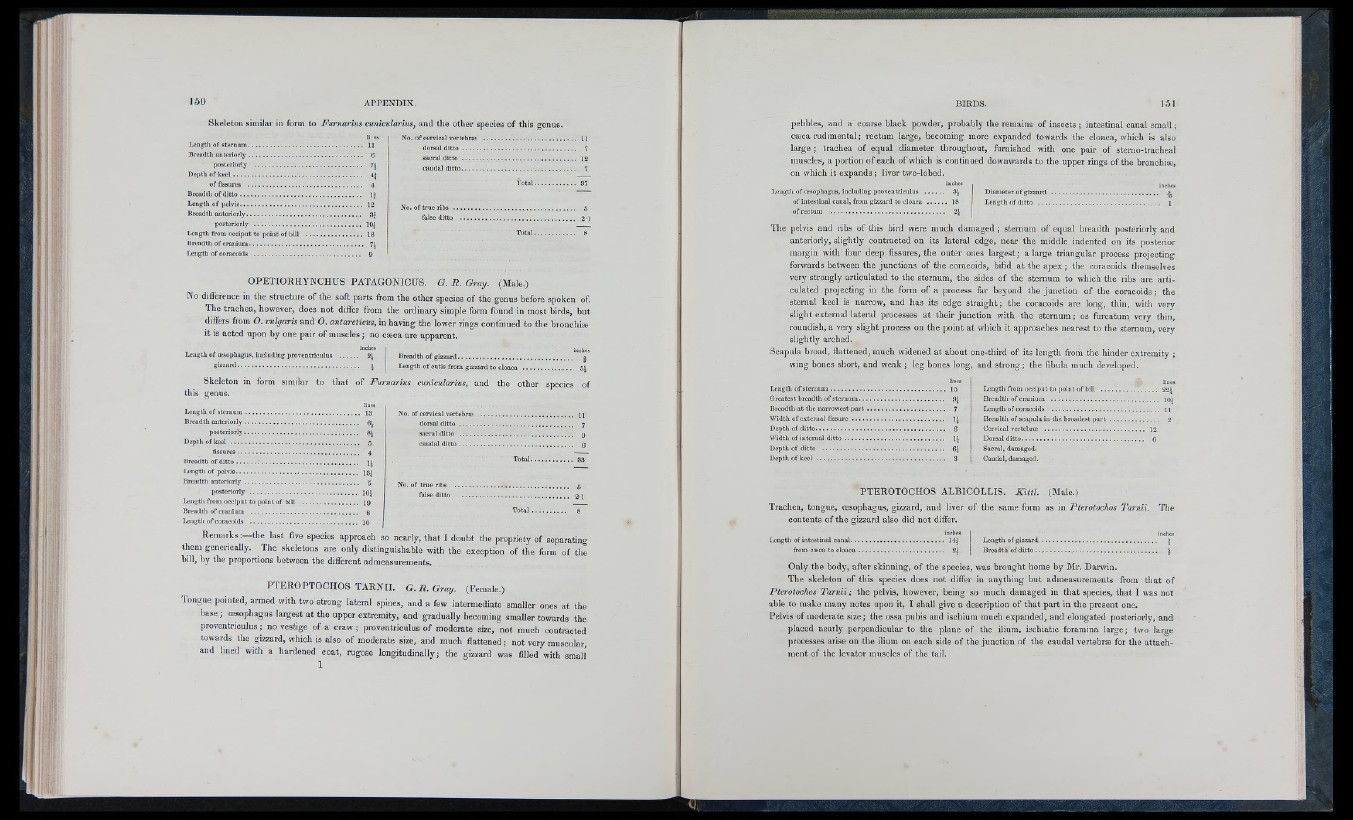
Skeleton similar in form to Furnarius cunicularius, and the other species of this genus.
No. of cervical vertebrtB ...................................................... l i
Length of sternum................................................................... n
Breadth anteriorly................................................................... 0
posteriorly ............................................................... 7^
Depth of k e e l............................................................................ 4^
o f fissures ................................................................... 4
Breadth o f d it to ....................................................................... q
Length o f pelvis........................................................................ 12
Breadth anteriorly................................................................... 8|
posteriorly ............................................................... 10^
Length from occiput to point o f bill ................................ 18
Breadth of cranium................................................................... 7J
Length of coracoids .............................................................. 9
dorsal d it to ................................................................... 7
sacral d it to ................................................................... 12
caudal ditto................................................................... 7
to t a l........................ 37
No. of true ribs ........................................................................ 5
false ditto .................................................................... 2'1
OPETIORHYNCHUS PATAGONICUS. G. R . Gray. (Male.)
No difference in the structure of the soft parts from the other species of the genus before spoken of.
The trachea, however, does not differ from the ordinary simple form found in most birds, but
differs from O. vulgaris and O. antarcticus, in having the lower rings continued to the bronchiæ
it is acted upon by one pair of muscles ; no cæca are apparent.
Length of cesophagus, including proventriculus Breadth o f gizzard. . .
Length o f cutis from g
Skeleton in form similar to that of Furnarius cunicularius, and the other species of
No. of cervical vertebroe ...................................................... n
dorsal d it to ................................................................... 7
sacral ditto ................................................................... g
caudal d itto ....................... «
Total..
No. of true ribs ................................................................... 5
false ditto ............................................................... 2-1
this genus.
Length of sternum................................................................... 13
Breadtli anteriorly................................................................... 9^
posteriorly...................................................................
Depth of k e e l ............................................................................ 5
fissures........................................................................ 4
Breadth o f d itto ........................................................................
Length of pelvis........................................................................ jg j
Breadth anteriorly................................................................... 5
posteriorly............................................................... 10^
Length from occiput to point o f bill ................................. 19
Breadth of cranium ............................................................... g
Length o f coracoids ............................................................... 10
Remarks:—the last five species approach so nearly, that I doubt the propriety of separating
them generieally. The skeletons are only distinguishable with the exception of the form of the
bill, by the proportions between the different admeasurements.
PTEROPTOCHOS TARNII. G .R .G r a y . (Pemale.)
Tongue pointed, armed with two strong lateral spines, and a few intermediate smaller ones at the
base ; cesophagus largest at the upper extremity, and gradually becoming smaller towards the
proventriculus ; no vestige of a craw : proventriculus of moderate size, not much contracted
towards the gizzard, which is also of moderate size, and much flattened ; not very muscular,
and lined with a hardened coat, rugose longitudinally; the gizzard was filled with small’
1
T
BIRDS.
pebbles, and a coarse black powder, probably the remains of insects ; intestinal canal small ;
cæca rudimentalj rectum large, becoming more expanded towards the cloaca, which is also
large ; trachea of equal diameter throughout, furnished with one pair of sterno-tracheal
muscles, a portion of each of which is continued downwards to the upper rings of the bronchiæ,
on which it expands ; liver two-lobed.
Diameter 0
Length of ditto ........................................................................ i
inches
Length of oesophagus, including proventriculus ........... 3^
of intestinal canal, from gizzard to cloaca . . . . . . 18
of rectum ...................................................................
The pelvis and ribs of this bird were much damaged ; sternum of equal breadth posteriorly and
anteriorly, slightly contracted on its lateral edge, near the middle indented on its posterior
margin with four deep fissures, the outer ones largest; a lai^e triangular process projecting
forwards between the junctions of the coracoids, bifid at the apex ; the coracoids themselves
very strongly articulated to the sternum, the sides of the sternum to which the ribs are articulated
projecting in the form of a process far beyond the junction of the coracoids; the
sternal keel is narrow, and has its edge straight; the coracoids are long, thin, with very
slight external lateral processes at their junction with the sternum; os furcatum very thin,
roundish, a very slight process on the point at which it approaches nearest to the sternum, very
slightly arched.
Scapula broad, flattened, much widened at about one-third of its length from the hinder extremity ;
wing bones short, and weak ; leg bones long, and strong; the fibula much developed.
lines
Length o f sternum...................................................................... 15
Greatest breadth o f sternum.................................................. 9j
Breadtli at the narrowest p a r t ................................................ 7
Width o f external fis su re ......................................................... q
Depth of ditto............................................................................... G
Width of internal d it to ........................................................... IJ
Depth of ditto ........................................................................
Depth of keel .............................................................................. 3
Length from occiput to point of bill ................................. 22^
Breadth o f cranium ............................................................... 10^
Length o f coracoids ................................................................. n
Breadth of scapula in the broadest p a r t ............................ 2
Cervical vertebræ ........................................................... 13
Dorsal ditto.......................................................................... 6
Sacral, damaged.
Caudal, damaged.
PTEROTOCHOS ALBICOLLIS. K ittl. (Male.)
Trachea, tongue, cesophagus, gizzard, and liver of the same form as in Pterotochos Tarnii. The
contents of the gizzard also did not differ.
Length o f intestinal canal-..
from cæca to cloaca .
inches
.. ^
Length o f gizzard ..................................................... |
Breadth of d itto ........................................................................ |
Only tbe body, after skinning, of the species, was brought home by Mr. Darwin.
The skeleton of this species does not differ in anything but admeasurements from that of
Pterotochos Tarnii; the pelvis, however, being so much damaged in that species, that I was not
able to make many notes upon it, I shall give a description of that part in the present one.
Pelvis of moderate size; the ossa pubis and ischium much expanded, and elongated posteriorly, and
placed nearly perpendicular to the plane of the ilium, ischiatic foramina large; two laro-e
processes arise on the ilium on each side of the junction of the caudal vertebrm for the attachment
of the levator muscles of the tail.